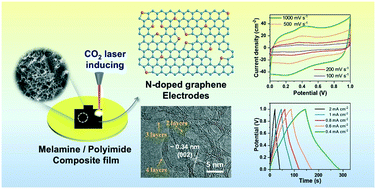One-step fabrication of nitrogen-doped laser-induced graphene derived from melamine/polyimide for enhanced flexible supercapacitors†
Abstract
Heteroatom doping of graphene electrodes is a valid strategy to enhance their capacitive performance. This work demonstrates a facile and expandable methodology for the in situ fabrication of nitrogen-doped laser-induced graphene (N-LIG) by the precursor composite approach in conjunction with laser induction technology. Melamine (C3H6N6) with high N content was compounded with polyimide to form a composite film, on which N-LIG was synthesized by one-step in situ laser pyrolysis. In this process, N elements from melamine were successfully doped into the graphene structure. As a result, the optimal N-LIG electrode exhibited a desirable specific areal capacitance (CA) of 56.3 mF cm−2 at 0.4 mA cm−2 in 1 M H2SO4 aqueous electrolyte, which was 7.2 times that of the pristine undoped LIG electrode. Besides, the N-LIG electrode obtained on the composite film kept good flexibility, which laid a foundation for the industrial roll to roll production of N-LIG. Furthermore, the N-LIG-based all-solid-state micro-supercapacitor (MSC) revealed a high CA of up to 35.20 mF cm−2 at 0.05 mA cm−2 and an impressive cyclic stability of 85.5% after 10 000 cycles. This presented strategy possesses the advantages of environmental protection, economy and convenience, and exhibits a broad application prospect in flexible wearable electronics and energy storage devices.



 Please wait while we load your content...
Please wait while we load your content...